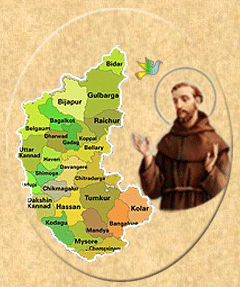
Contact :
'Saccidananda'
Capuchin
Provincialate
Dr. Rajkumar Road, P.B.No.1060, Rajajinagar, Bangalore-560 010
Karnataka, India.
Tel:
+91-080-23377790
+91-080-23470178
Fax:
+91-080-23474342
E-Mail
cappro@rediffmail.com
psecretary@rediffmail.com

 


St. Padre Pio
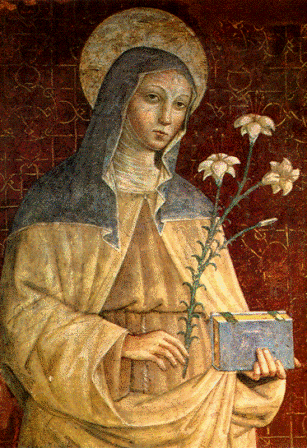
St. Clare of Assisi

Tau Cross

Damiano Cross |
| |
|
the houses of the province |
|
|
Saccidananda,
Capuchin Provincialate, Bangalore
 Ever since the Holy Trinity Province of
Karnataka-Goa- Maharashtra was culled out from the erstwhile single
province of India, the friars have been looking forward to the
realization of a Provincial House. As the history has it, the Provincialate was shifted from place to place. It was first housed at
Monte de Guirim Goa and then at Deena Seva Ashram, Bangalore. To
render more effective and prompt service to brothers as well as to
have an easy access, it has now found a permanent residence at
Saccidananda, Rajajinagar, Bangalore. The Provincialate was
inaugurated on December 29, 1995. Ever since the Holy Trinity Province of
Karnataka-Goa- Maharashtra was culled out from the erstwhile single
province of India, the friars have been looking forward to the
realization of a Provincial House. As the history has it, the Provincialate was shifted from place to place. It was first housed at
Monte de Guirim Goa and then at Deena Seva Ashram, Bangalore. To
render more effective and prompt service to brothers as well as to
have an easy access, it has now found a permanent residence at
Saccidananda, Rajajinagar, Bangalore. The Provincialate was
inaugurated on December 29, 1995.
St.Fidelis
Friary, Monte Mariano, Farangipet
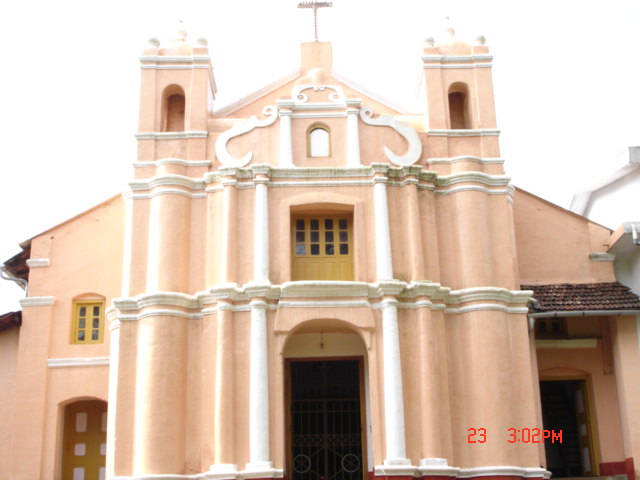 A dilapidated chapel dedicated to St.
Francis of Assisi and a tottering old building, which once belonged to
the Portuguese Franciscans, was standing on the little hillock, called
Monte Mariano, at Farangipet. The buildings with the adjoining
compound were placed by the Bishop of Mangalore at the disposal of the
Capuchins for the purpose of the novitiate house when they came to
Farangipet in May 1930. The chapel was repaired and on its side was
constructed the novitiate block. Until 1969, this was the only
novitiate house of the Capuchins in India.Aseraphic school was also
attached to it until 1949. The novitiate for the non-clerical friars
was shifted to Muvattupuzha (Kerala) in 1963. The Junior Professorium
was conducted at Monte Mariano from 1966-70 for the non-clerical
friars. After the erection of the new Province, the novitiate was
brought back to Farangipet in 1973 and has continued to be there to
date. In June 1978, the Initiation Course located at St. Fidelis
Ashram, Lucknow, Mahanagar, on an experimental basis since June 1973,
was once again shifted to Monte Mariano. A dilapidated chapel dedicated to St.
Francis of Assisi and a tottering old building, which once belonged to
the Portuguese Franciscans, was standing on the little hillock, called
Monte Mariano, at Farangipet. The buildings with the adjoining
compound were placed by the Bishop of Mangalore at the disposal of the
Capuchins for the purpose of the novitiate house when they came to
Farangipet in May 1930. The chapel was repaired and on its side was
constructed the novitiate block. Until 1969, this was the only
novitiate house of the Capuchins in India.Aseraphic school was also
attached to it until 1949. The novitiate for the non-clerical friars
was shifted to Muvattupuzha (Kerala) in 1963. The Junior Professorium
was conducted at Monte Mariano from 1966-70 for the non-clerical
friars. After the erection of the new Province, the novitiate was
brought back to Farangipet in 1973 and has continued to be there to
date. In June 1978, the Initiation Course located at St. Fidelis
Ashram, Lucknow, Mahanagar, on an experimental basis since June 1973,
was once again shifted to Monte Mariano.
The gradual increase in the number of
vocations in the Province since 1987 and the need for providing
accommodation for the candidates of St. Fidelis Vice-Province erected
in the North in September 1981, made it necessary to take up the
construction of a new block in 1982.
Presently, though the formation of
the novices is the main ministry of the friars at Monte Mariano, they
also render pastoral service to the parishes around. To mark the
Golden Jubilee of the friary, St. Fidelis Commerce Institute with
about 100 students was started in May 1982 in a rented building. The
proposal for a new building to accommodate the increasing number of
students of the commerce institute and the tailoring section was
approved in August 1982. The building completed in 1987 now houses
about 100 students.
St.Anne's Friary, Mangalore
 The place, originally known as "Lawn
View" and measuring 45 cents, belonged to Mr. George Lobo, a retired
jailor.He gifted the place and his house to the Capuchins in May 1936,
in memory of his deceased wife, Mrs. Annie Lobo. Hence the friary is
named after St. Anne. Earlier the house was used as a centre for
Franciscan gatherings. A hall was erected for this purpose in 1937,
which served also as a chapel and eventually became the Portiuncula,
dedicated to Our Lady of Angels. In 1941 the house of Mr. George Lobo
was declared a hospice attached to St. Fidelis Friary, Farangipet.
Some friars started staying here for the purpose of doing social work
and other pastoral ministry in the town. A shrine of St. Anthony was
constructed at the corner of the triangle during the same year. The place, originally known as "Lawn
View" and measuring 45 cents, belonged to Mr. George Lobo, a retired
jailor.He gifted the place and his house to the Capuchins in May 1936,
in memory of his deceased wife, Mrs. Annie Lobo. Hence the friary is
named after St. Anne. Earlier the house was used as a centre for
Franciscan gatherings. A hall was erected for this purpose in 1937,
which served also as a chapel and eventually became the Portiuncula,
dedicated to Our Lady of Angels. In 1941 the house of Mr. George Lobo
was declared a hospice attached to St. Fidelis Friary, Farangipet.
Some friars started staying here for the purpose of doing social work
and other pastoral ministry in the town. A shrine of St. Anthony was
constructed at the corner of the triangle during the same year.
Since Mr. George Lobo was still
living in one of the rooms of his old house and the friars needed
privacy, a temporary residence was constructed behind the shrine of
St.Anthony in 1943. In 1950, after the death of Mr. George Lobo, the
temporary residence was demolished and the old house of Mr. Lobo was
re-modeled and the chapel was enlarged. For the purpose of promoting
vocations to the Order, the Assisi House was started in 1955 in a
small rented building. The compound, measuring about 2 acres,
adjoining the friary and known as 'Grasmere', which belonged to Mr.
P.C. Lobo, the brother of Mr. George Lobo, was acquired in 1960 and
the Assisi House was shifted to its present premises.
The old house constructed by Mr.
George Lobo at Lawn View and which had housed the friars for more than
25 years, having become inconvenient for habitation, was demolished in
1977 and on the same site the new friary was constructed and completed
in 1979. The students ofPUCwere accommodated in the Friary from 1979
to 1983.
In 1983 the PUC students were shifted
to the Assisi House which itself was rebuilt in the year 1967 to
accommodate the increasing number of boys studying in Assisi House.
From 1987 Assisi House looked after only capuchin candidates who did
their PUC studies. In August 1999, Postulancy ofKGMwas shifted
toAssisi House.
The friary has many initiatives to
its credit. In early 1950's, under the leadership of Fr. Cyril Andrade
the S.F.O. apostolate began in Mangalore. Later, under the leadership
of Fr. Vincent Lobo, the S.F.O. ministry thrived in Mangalore diocese.
In 1943 the Konkani Natak Sabha started by Fr. GeorgeAlbuquerque Pai
S.J. was transferred to the Capuchins of St. Anne's Friary. Fr. Cyril
Andrade became its president. By 1951, under the leadership of Fr.
Philip Neri, a good Hall, named Don Bosco, was built and to-date the
Capuchins direct the sociocultural activities of the K.N.S. Some years
later, Fr. Vincent Lobo started the Konkani family monthly magazine,
"Sevak" which saw its first issue in September 1959. He also started
Assisi Press in 1970 as a landmark in the media apostolate of the
Province.
The friars are now engaged in varied
forms of apostolate: preaching, spiritual assistance to the S.F.O.,
promoting vocations, apostolate of the press and the stage.
Holy Family
Friary, Brahmavar
 Brahmavar has a special prominence in
the history of the diocese of Mangalore because of the schism, which
took place in 1887. The priests in charge of the parish at Brahmavar
had worked zealously for the reunion of movement and to render
pastoral assistance to the diocesan clergy in the Northern part of the
diocese. The Bishop of Mangalore however entrusted the pastoral care
of the parish, along with the two substations Petre and Nilavar to the
Capuchins on 15April 1956. They completed the plastering and flooring
of the Church, which along the new belfry was blessed inApril 1961. Brahmavar has a special prominence in
the history of the diocese of Mangalore because of the schism, which
took place in 1887. The priests in charge of the parish at Brahmavar
had worked zealously for the reunion of movement and to render
pastoral assistance to the diocesan clergy in the Northern part of the
diocese. The Bishop of Mangalore however entrusted the pastoral care
of the parish, along with the two substations Petre and Nilavar to the
Capuchins on 15April 1956. They completed the plastering and flooring
of the Church, which along the new belfry was blessed inApril 1961.
The fraternity at Brahmavar was
canonically erected on 28 February 1960. The friary building was
completed and blessed on 19 December 1966.Anew church was erected at
Petre through the efforts of the friars and by 1968, Petre was
separated from Brahmavar as an independent parish, now cared for by
the diocesan clergy. The chapel at Nilavar was built in 1967. While
taking good care of the Brahmavar parish, the friars also render
sacramental ministry to the neighbouring parishes, give spiritual
assistance to the SFO, preach retreats and recollections to various
religious and lay groups and promote vocations to the Order.
Deena Seva
Ashram, Bangalore
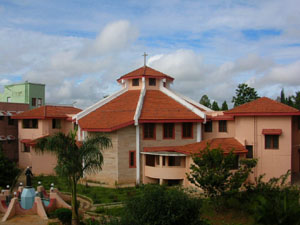 In 1965 the friars went in search of a
place for a friary in Bangalore at Kengeri. The present site at the
Valagerehalli was bought in 1968. The construction of a friary was
begun in 1971 and it was blessed and declared a canonically erected
house in 1974. In 1965 the friars went in search of a
place for a friary in Bangalore at Kengeri. The present site at the
Valagerehalli was bought in 1968. The construction of a friary was
begun in 1971 and it was blessed and declared a canonically erected
house in 1974.
In 1976 an additional block was
constructed with self-contained rooms for the sick and aged friars.
When the Orientation Course had to be shifted here from Monte Mariano
in June 1980, the construction of an additional floor was taken up. In
1981 the common study houses of the four jurisdictions were wound up
in favour of regionalization and inculturation. The Provincial Chapter
accordingly decided to conduct the entire programme of formation of
our candidates from Orientation to Theology in our own province. Deena
SevaAshram thus became the major study house for students of
Philosophy and Theology and Professorium Brothers from June 1981. The
Orientation Course was shifted from Bangalore to Navelim.
As the number of the students of
Philosophy steadily increased it was found necessary to shift the
Theologate to Kripalaya, Mysore, in the year 1985. Deena Seva Ashram
became the institute of philosophy and religion. Meanwhile the bishop
requested that it be made a quasiparish so as to meet the pastoral
requirements of the people around especially those who steadily came
to settle down in the near-by satellite town. The Capuchins took
diligent care of this parish until a new parish church was built in
the Kengeri Satellite Town and the Archbishop appointed a diocesan
priest as the pastor in July 2002.
At Deena Seva Ashram a new auditorium
was blessed on August 31, 1997. A new Chapel, Library and Dining Hall
was constructed to accommodate increasing number of students.
The provincial chapter of April 2007
took a historical decision to shift the present philosophate at Deena
Seva Ashram to Kripalaya, Bogadi, Mysore and the theologate at
Kripalaya to Deena Seva Ashram Bangalore, keeping in mind the concept
of Campus Theology and also to promote the activities of Darshan
Research Institute. The mutual transfer of houses took place on June
25, 2007. The theologate was re-christened as 'Darshan Institute of
Theology".
St.Joseph's
Friary, Lower Kasarkod, Honnavar
 When North Kanara formed a part of the
diocese of Belgaum, the parish of St. Joseph at Lower Kasarkod was
permanently entrusted to the pastoral care of the Capuchins in 1975,
on the understanding that they would also look after the pastoral
needs of five other parishes at Samsi, Kodani, Molkod, Gundibala and
Binaga. When North Kanara formed a part of the
diocese of Belgaum, the parish of St. Joseph at Lower Kasarkod was
permanently entrusted to the pastoral care of the Capuchins in 1975,
on the understanding that they would also look after the pastoral
needs of five other parishes at Samsi, Kodani, Molkod, Gundibala and
Binaga.
Later in 1976 North Kanara became the
new diocese of Karwar and the earlier agreement was slightly altered.
The parishes of Samsi and Binaga were ceded to the diocese in 1981 and
the friars continued to work just in four parishes of Gundibala,
Kodani, Molkod and Lower Kasarkod. The latter became the centre for
the entire area. In 1986, the parishes of Gundibala, Kodani and Molkod
were also ceded to the diocese, retaining thus only St. Joseph's
Church, Lower Kasarkod for the friars. The foundation for the new
church at Lower Kasarkod was laid on 1 May 1977 and the new Church was
completed on 30 April 1979.Anew house for the friars was constructed
in 1990.
Ravi Ashram,
Bankal
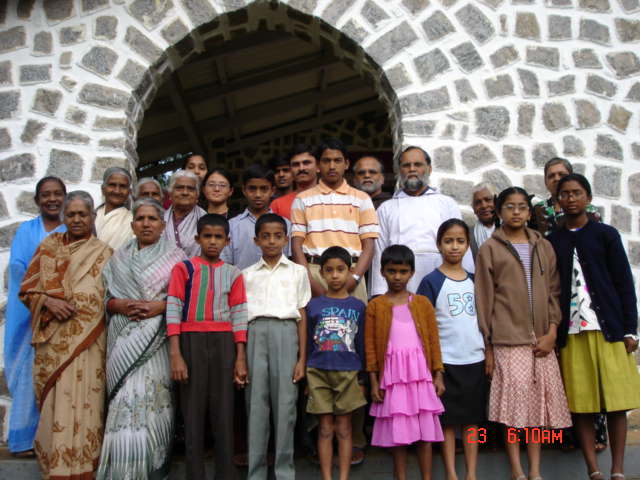 Early in 1962 two friars were working in Bhadravati in Chikmagalur diocese. They however withdrew from there in
1964. Ever since a proposal to start a new foundation in Chikmagalur
diocese was under consideration.When the Bishop of the diocese offered
to the Capuchins 2 acres of vacant land at Bankal for the purpose of
erecting a church and a residence, the offer was gladly accepted on 7
July 1973. The parish church dedicated to infant Mary was completed
and blessed in 1975. The parish has two sub-stations, one at Javali
and other at Balur.Anew chapel at Balur was constructed in 1990. Early in 1962 two friars were working in Bhadravati in Chikmagalur diocese. They however withdrew from there in
1964. Ever since a proposal to start a new foundation in Chikmagalur
diocese was under consideration.When the Bishop of the diocese offered
to the Capuchins 2 acres of vacant land at Bankal for the purpose of
erecting a church and a residence, the offer was gladly accepted on 7
July 1973. The parish church dedicated to infant Mary was completed
and blessed in 1975. The parish has two sub-stations, one at Javali
and other at Balur.Anew chapel at Balur was constructed in 1990.
The construction of the hostel for
poor students, coming to Bankal from remote villages for high school
studies, was undertaken in 1979, with the financial help given by the
planters.
Dayal Bagh
Ashram, Ujire
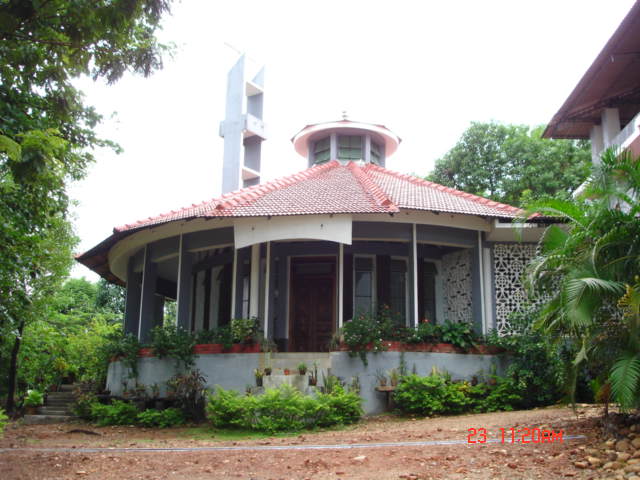 Dayal Bagh, begun as a farm in 1969, has
grown into an Ashram today and is raised to the status of 'Domus
Formata'. At first it was started on a plot of land measuring about 5
acres in view of the social uplift of the poor villages around. Later
on more land was acquired and agricultural cum horticultural work was
undertaken. The idea was to make Dayal Bagh a model farm. Accordingly,
piggary, poultry and dairy were undertaken as additional activities.
Several developmental projects are under way since the inception of
the farm Dayal Bagh, begun as a farm in 1969, has
grown into an Ashram today and is raised to the status of 'Domus
Formata'. At first it was started on a plot of land measuring about 5
acres in view of the social uplift of the poor villages around. Later
on more land was acquired and agricultural cum horticultural work was
undertaken. The idea was to make Dayal Bagh a model farm. Accordingly,
piggary, poultry and dairy were undertaken as additional activities.
Several developmental projects are under way since the inception of
the farm
A government-recognized agricultural
school that began around 1980 is engaged in training young and
enterprising farmers. A new residence for the friars and a nice-little
chapel for worship were completed between 1979-85. The agricultural
students also have their own quarters to stay at Dayal Baugh during
their studies. At present the developmental activities in and around
Ujire are efficiently carried on through 'Vimukti' Ujire begun in the
year 1996. These activities also come under the umbrella of Capuchin
Krishik Seva Kendra, a registered society. From 1996 June Dayal Bagh
Ashram is also the house of Orientation andAspirancy along with the
NIOS programme. From 2008 Dayalbagh will be housing only Aspirancy
students who will do their PUC in the neighbouring colleges.
Kripalaya,
Capuchin Theologate, Mysore
 It was in 1978 that the Provincial
Definitory decided to acquire a plot of land in Mysore to open a
formation house for PUC students. The negotiations for this plot
however did not succeed. In 1983 the friars managed to acquire another
piece of agricultural plot just outside the city limits of Mysore,
close to Manasa Gangotri University. It was named Kripalaya and
initially just two friars lived in the farm house. When it became
obvious that the Theologate from Deena SevaAshram, Bangalore had to be
shifted, in keeping with the decision of the fifth Provincial Chapter
of 1984, it was decided to plan a new Theologate at Kripalaya, Mysore.
In 1987, the first phase of the new building was ready for occupation
and in 1989 the construction of the entire Theologate was over. The
Seminary chapel, beautifully built in Indian style was blessed in
February 1992. It was in 1978 that the Provincial
Definitory decided to acquire a plot of land in Mysore to open a
formation house for PUC students. The negotiations for this plot
however did not succeed. In 1983 the friars managed to acquire another
piece of agricultural plot just outside the city limits of Mysore,
close to Manasa Gangotri University. It was named Kripalaya and
initially just two friars lived in the farm house. When it became
obvious that the Theologate from Deena SevaAshram, Bangalore had to be
shifted, in keeping with the decision of the fifth Provincial Chapter
of 1984, it was decided to plan a new Theologate at Kripalaya, Mysore.
In 1987, the first phase of the new building was ready for occupation
and in 1989 the construction of the entire Theologate was over. The
Seminary chapel, beautifully built in Indian style was blessed in
February 1992.
Besides the formation work, the
friars are also engaged in active apostolate in the diocese. The
Hinkal mission near-by was entrusted to the care of Kripalaya, which
has been given back to the diocese in 1998. Apart from the regular
chaplaincy to several convents, the friars also give recollections to
different communities and preach retreats to religious.
According to the mandate of the
provincial chapter 2007, the Theologate was transferred to Deena Seva
Ashram, Kengeri on June 25, 2007 and the Institute of Philosophy and
Religion was brought to Kripalaya on the same day.
St.Anthony's
Church, Hosanagar
 At the pressing appeal of Bishop
Ignatius Pinto of Shimoga, the small parish at Hosanagar, with about
350 Catholics, was accepted on a temporary basis. The Provincial
Chapter of March 1990 favoured the continued presence and ministry of
the friars in the parish in the diocese of Shimoga. Accordingly a
wholly new church and a friary were built so as to provide good
service to the people and a convenient residence to the friars. At the pressing appeal of Bishop
Ignatius Pinto of Shimoga, the small parish at Hosanagar, with about
350 Catholics, was accepted on a temporary basis. The Provincial
Chapter of March 1990 favoured the continued presence and ministry of
the friars in the parish in the diocese of Shimoga. Accordingly a
wholly new church and a friary were built so as to provide good
service to the people and a convenient residence to the friars.
Shanthi
Sadhana, Bangalore
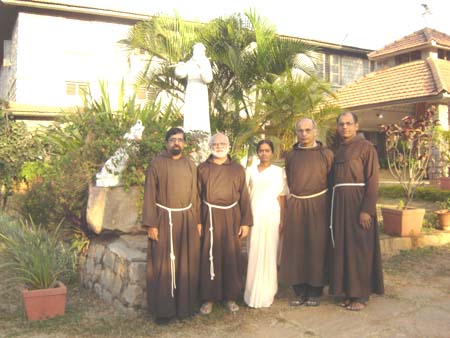 It all began in 1987. The inspiration of
the Franciscan Institute of Spirituality in India (FISI) was that of
the General Minister and his Definitory. Holy Trinity Province of
Karnataka-Goa-Maharashtra was to respond actively by taking a bold
step of initiating and implanting the FISI Project under the
supervision of CCMSI. In the realization of the same the province has
the full backing of the General Definitory. 9 acres of land belonging
to Deena Seva Ashram has been gifted by the Province for this purpose
and the implementation of the project has quickly picked up. Many
courses in Franciscan Spirituality and Charism had meanwhile been
organized all over India under the aegis of FISI. Many more programmes
are being chalked out, thanks to the collaboration of the friars from
all the capuchin jurisdictions in India, including the Friars Minor
and some women Franciscans. It all began in 1987. The inspiration of
the Franciscan Institute of Spirituality in India (FISI) was that of
the General Minister and his Definitory. Holy Trinity Province of
Karnataka-Goa-Maharashtra was to respond actively by taking a bold
step of initiating and implanting the FISI Project under the
supervision of CCMSI. In the realization of the same the province has
the full backing of the General Definitory. 9 acres of land belonging
to Deena Seva Ashram has been gifted by the Province for this purpose
and the implementation of the project has quickly picked up. Many
courses in Franciscan Spirituality and Charism had meanwhile been
organized all over India under the aegis of FISI. Many more programmes
are being chalked out, thanks to the collaboration of the friars from
all the capuchin jurisdictions in India, including the Friars Minor
and some women Franciscans.
The institute was solemnly
inaugurated by Most Rev. Fr. Flavio Carraro, the General Minister and
blessed by Most Rev.Dr. Alphonsus Mathias, the thenArchbishop of
Bangalore, on 7 Dec. 1993. Since this institute has been entrusted to
our province for its ordinary administration, a team of friars reside
there since June 1993.
Clara Vihar,
Potnal, Bellary
 The diocese of Bellary, represented by
Bishop Joseph D'Silva, formally invited the Capuchins of the Holy
Trinity Province to open a house anywhere in the diocese, through his
letter dated 5 May 1993. After a spot study of various places, through
his letter dated 11 October 1993, Fr. Andrew Anil Sequeira, the then
Provincial Minister, communicated the decision of the Provincial Definitory, expressing willingness to take up Potnal in the district
of Raichur. In the month of May 1994, the Provincial Definitory
assigned two friars as the first Capuchins to Potnal Mission. These
arrived in Bellary on 5 June 1994 and proceeded to Potnal, to be
accommodated in the Jawalgera farm ofthe diocese. The diocese of Bellary, represented by
Bishop Joseph D'Silva, formally invited the Capuchins of the Holy
Trinity Province to open a house anywhere in the diocese, through his
letter dated 5 May 1993. After a spot study of various places, through
his letter dated 11 October 1993, Fr. Andrew Anil Sequeira, the then
Provincial Minister, communicated the decision of the Provincial Definitory, expressing willingness to take up Potnal in the district
of Raichur. In the month of May 1994, the Provincial Definitory
assigned two friars as the first Capuchins to Potnal Mission. These
arrived in Bellary on 5 June 1994 and proceeded to Potnal, to be
accommodated in the Jawalgera farm ofthe diocese.
The diocese then entrusted to the
Capuchins of Holy Trinity Province, the 10 stations of the Potnal
Mission territory, viz., Mudengudi, Karabdinni, Jeenur Camp, Donmaldi,
Jeenur, Tadakal, Dotharabandi, Udbal, Markamdinni, and Belavatta,
which hitherto formed the parts of the Jawalgera parish, for the
spiritual and pastoral care of the people of God. The diocese also
placed at the disposal of the Capuchins the diocesan property situated
at Potnal village measuring 9 acres and 15 guntas. The new Capuchin
House, 'Clara Vihar' was inaugurated on 21 March 1996 by Fr. Remigius
Sequeira, the provincial Minister and blessed by Rt. Rev. Dr. Joseph
D'Silva, Bishop of Bellary.
The Provincial Chapter of May 1996
decided to house the Post- Novitiate formation of the brothers at
Potnal.Anew structure suitable for this stage of formation was put up
and the formation commenced from October, 1998. On the other hand
special attention is being given by the friary to the developmental
activities in the nearby villages of Potnal through 'Vimukti'.
Prem Nivas,
St.Anthony's Institutions, Gangondanahalli
 The Capuchins of Deena SevaAshram had
been rendering pastoral services in the substation of Gangondanahalli
since 1975. The Archdiocese of Bangalore, represented by the
Archbishop, Rt. Rev. Dr. Arokiasamy, formally requested the Capuchins
to take care of the pastoral needs of this area, as one of the
substations of Kengeri quasiparish, by his letter dated 3 November
1982. A Kannada medium school, dedicated to St. Anthony was opened
soon thereafter in a small hut with cement sheet roof. The area has
seen a rapid development even as the development of the parish and
school. The Capuchins of Deena SevaAshram had
been rendering pastoral services in the substation of Gangondanahalli
since 1975. The Archdiocese of Bangalore, represented by the
Archbishop, Rt. Rev. Dr. Arokiasamy, formally requested the Capuchins
to take care of the pastoral needs of this area, as one of the
substations of Kengeri quasiparish, by his letter dated 3 November
1982. A Kannada medium school, dedicated to St. Anthony was opened
soon thereafter in a small hut with cement sheet roof. The area has
seen a rapid development even as the development of the parish and
school.
A church and school building along
with the residential quarters were constructed by the Capuchins on the
land donated by Mr. M. Joseph and were inaugurated and blessed by Rt.
Rev. Dr. Alphonsus Mathias, the then Archbishop of Bangalore, on 31
October 1993. Earlier it was erected into a full-fledged parish and
entrusted to the Capuchins 'ad perpetuum' through an agreement dated
25 August 1993. The St. Antony English School started by the Friars is
making good progress.
Christalaya,
Chikkodi
 The Holy Rosary Church, Tumarikop, in
Belgaum diocese, was entrusted to us for pastoral care, due to some
insoluble problems. It was however handed back to the diocese in July
1997 after resolving the problems to a very great extent. As Bishop
Bernard Moras desired that the Capuchins continue their work in his
diocese, another place, namely, Chikkodi was accepted by us to
continue our serviceable presence in the diocese. At Chikkodi, our
presence is purely missionary, as there are no Catholics around. Since
November 1997 the friars been residing in a rented house and while
doing social work through 'Vimukti', Chikkodi, they also cooperate
with the diocese in various developmental projects. A new school has
been just begun in view of meeting the educational needs of the
place.A new house has been built for the residence of the Friars and
to house the offices of Vimukti. The Holy Rosary Church, Tumarikop, in
Belgaum diocese, was entrusted to us for pastoral care, due to some
insoluble problems. It was however handed back to the diocese in July
1997 after resolving the problems to a very great extent. As Bishop
Bernard Moras desired that the Capuchins continue their work in his
diocese, another place, namely, Chikkodi was accepted by us to
continue our serviceable presence in the diocese. At Chikkodi, our
presence is purely missionary, as there are no Catholics around. Since
November 1997 the friars been residing in a rented house and while
doing social work through 'Vimukti', Chikkodi, they also cooperate
with the diocese in various developmental projects. A new school has
been just begun in view of meeting the educational needs of the
place.A new house has been built for the residence of the Friars and
to house the offices of Vimukti.
Bala Yesu
Nivas, Chikmagalur
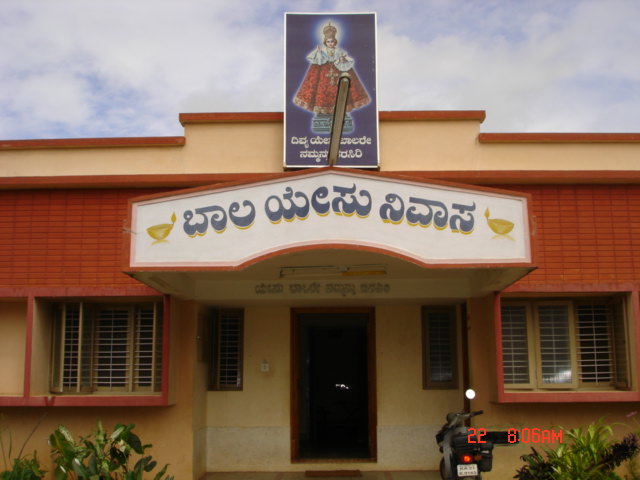 To establish a praying and evangelizing
fraternity at Chikmagalur, Bishop John Baptist Sequeira offered the
Capuchins in 1977 a plot of land on the Chikmagalur-Bankal road. The
Provincial Minister and his definitory, having accepted the offer,
planned to construct a small friary. It was accomplished in the year
2000 and dedicated to Infant Jesus to commemorate theYesu Krista
Jayanti 2000. The friary has the potentiality of growing into a
pilgrimage centre in the diocese. Plans are afoot to begin an
educational institution for a more effective Capuchin presence in
Chikmagalur. For this purpose twelve acres of land has been purchased
in Kadri Midri, five km away from Bala Yesu Nivas. A school building
is being planned in the plot for Infant Jesus School. To establish a praying and evangelizing
fraternity at Chikmagalur, Bishop John Baptist Sequeira offered the
Capuchins in 1977 a plot of land on the Chikmagalur-Bankal road. The
Provincial Minister and his definitory, having accepted the offer,
planned to construct a small friary. It was accomplished in the year
2000 and dedicated to Infant Jesus to commemorate theYesu Krista
Jayanti 2000. The friary has the potentiality of growing into a
pilgrimage centre in the diocese. Plans are afoot to begin an
educational institution for a more effective Capuchin presence in
Chikmagalur. For this purpose twelve acres of land has been purchased
in Kadri Midri, five km away from Bala Yesu Nivas. A school building
is being planned in the plot for Infant Jesus School.
Asha Kiran,
Bhadravati
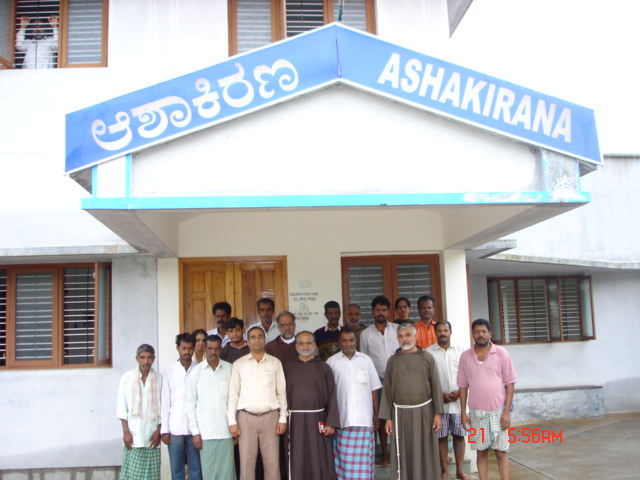 Noticing the need of a rehabilitation
centre for de-addiction of alcoholics and substance-abuse persons, a
beginning was made at Kengeri in the year 1994. As the land that
housed 'Asha Kiran' was notified by the Bangalore development
authority, the healing ministry had to be shifted. It was decided to
transfer the same to Bhadravati where the Capuchins had a small
stretch of land.With the generous help of Swiss Capuchin Province and
International Office of Solidarity a friary as well as the centre
became a reality. It was inaugurated on November 14, 2001. It is
envisaged that the fraternity while carrying on the ministry in the
rehabilitation centre, shall also involve itself in pastoral work in
the entire diocese of Shimoga. Noticing the need of a rehabilitation
centre for de-addiction of alcoholics and substance-abuse persons, a
beginning was made at Kengeri in the year 1994. As the land that
housed 'Asha Kiran' was notified by the Bangalore development
authority, the healing ministry had to be shifted. It was decided to
transfer the same to Bhadravati where the Capuchins had a small
stretch of land.With the generous help of Swiss Capuchin Province and
International Office of Solidarity a friary as well as the centre
became a reality. It was inaugurated on November 14, 2001. It is
envisaged that the fraternity while carrying on the ministry in the
rehabilitation centre, shall also involve itself in pastoral work in
the entire diocese of Shimoga.
Anugraha
Gurumatha, Halbarga, Bidar
 The diocese of Mangalore under the
leadership of Bishop Aloysius D' Souza invited the Capuchins in the
year 2000 to actively involve themselves in the mission of Bidar
district which the diocese itself had been looking after for almost
two decades. On accepting the invitation we were offered the mission
of Halbarga along the Bidar-Latur road. The process of establishing
our presence was initiated by the purchase of a piece of land to
establish our 'mission house'. The ground floor of the Friary was
blessed on 30th May 2007. The Provincial Definitory has decided to
construct the first floor and establish the formation stage of
Postulancy in the Friary. The diocese of Mangalore under the
leadership of Bishop Aloysius D' Souza invited the Capuchins in the
year 2000 to actively involve themselves in the mission of Bidar
district which the diocese itself had been looking after for almost
two decades. On accepting the invitation we were offered the mission
of Halbarga along the Bidar-Latur road. The process of establishing
our presence was initiated by the purchase of a piece of land to
establish our 'mission house'. The ground floor of the Friary was
blessed on 30th May 2007. The Provincial Definitory has decided to
construct the first floor and establish the formation stage of
Postulancy in the Friary.
Assisi Vihar,
Shirvad, Karwar, Diocese of Karwar
There was a long awaited plan to open a
second house in the diocese of Karwar and efforts were on to find a
suitable place convenient for the friars to render the pastoral
assistance to the diocese and meet the spiritual needs of the
religious of the diocese. The provincial minister Br. Jossy Fernandes
negotiated with the Bishop of Karwar and established a second house in
the Diocese on 28th January 2006 and the General Minister Br. John
Corriveau by his decree dated 7th April 2006 erected the house
canonically.
Holy Trinity
Mission, Shiggaon, Diocese of Belgaum
To have a second house in the diocese of
Belgaum was a dream and aspiration of many and few of the former
provincials were constantly on the search for a suitable place in
Hubli city area. The present bishop of the diocese of Belgaum, Rt.
Rev. Dr. Peter Machado has offered the mission of Shiggaon on a
temporary basis.
Mission of Madhya Pradesh
Shanthi
Nilaya, Itarsi
 On his assuming the charge of the
archdiocese of Bhopal, Archbishop Eugene D'Souza invited the Capuchins
to work in the newly carved out diocese.After due negotiations the
Maltese Capuchin Province took charge of the Bhopal Mission in 1966,
and the district of Hoshangabad was entrusted to their care. The
Church of Sacred Heart of Jesus, Itarsi, was made the residence of the
Superior Regular. The Provincial Chapter of 1987 voted in favour of
accepting the State of Madhya Pradesh as the mission of the Holy
Trinity Province. Since then some more friars have been working in the
mission. On his assuming the charge of the
archdiocese of Bhopal, Archbishop Eugene D'Souza invited the Capuchins
to work in the newly carved out diocese.After due negotiations the
Maltese Capuchin Province took charge of the Bhopal Mission in 1966,
and the district of Hoshangabad was entrusted to their care. The
Church of Sacred Heart of Jesus, Itarsi, was made the residence of the
Superior Regular. The Provincial Chapter of 1987 voted in favour of
accepting the State of Madhya Pradesh as the mission of the Holy
Trinity Province. Since then some more friars have been working in the
mission.
In 1997, when Br. Vincent Gabriel
Furtado was the Provincial Minister the new Friary was completed. In
1998 the new church was blessed and inaugurated by Archbishop Pascal
Topno S.J.
Vianney
Sadan, Bhopal
In 1987 after having decided to accept
Madhya Pradesh as its mission territory, the Province sent three
friars at the invitation of the Archbishop Eugene D'Souza. They made
Seva Sadan at Tulsi Nagar as their residence. However as the
Archbishop required Seva Sadan to conduct his own minor seminary, our
friars had to move out and find a new shelter in a rented house at
Nehru Nagar.
A portion of Seva Sadan parish was
entrusted to them for pastoral care.With a view to building a friary,
a parish church and a school, 10 acres of land was purchased at
Barkhedi Khurd at a distance of 4 km. from Nehru Nagar. The distance
made the immediate realization of the plan impossible and hence
another plot of land was purchased at Nehru Nagar itself and a prayer
hall cum residence was constructed, named after St. John Mary Vianney.
It is now raised to the status of a parish.
The 3rd Provincial Chapter of 2004
decided to ask for the collaboration of the Vice Province of
Maharashtra in Madhya Pradesh, so that it can gradually become the
mission of Maharashtra province.
The
North East Missions
The Provincial Chapter
of May 1996 recommended that the mission activity be extended to the
North East regions. As per the recommendation of CCMSI, the General
Minister assigned to Holy Trinity Province, the states of Nagaland,
Mizoram, Manipur, Tripura and a part of Assam for missionary activity
and implantation of the Order. (Prot. No. 00570/97 dated June 27,
1997).
St.Francis
Assisi Church, Lazami, Kohima, Nagaland
 At the repeated call of Rt. Rev. Abraham
Alangimattathil, S.D.B., of the Diocese of Kohima, to work in Nagaland,
Fr. Remigius Sequeira, the then Provincial Minister, made a survey of
Kohima diocese and preferred to take up the Sema area for mission
work. The Capuchin presence was established at Lazami in the diocese
of Kohima, when Br. Vincent Gabriel Furtado was the Provincial
Minister and Bishop Abraham Alangimattathil introduced our friars to
the Catholic community on 10 July 1996. The Lazami community, which
was a substation of Tsemenu parish, was given an independent status.
It is now a parish under the patronage of St. Francis of Assisi, with
three substations, an higher primary school and a hostel for boys. At the repeated call of Rt. Rev. Abraham
Alangimattathil, S.D.B., of the Diocese of Kohima, to work in Nagaland,
Fr. Remigius Sequeira, the then Provincial Minister, made a survey of
Kohima diocese and preferred to take up the Sema area for mission
work. The Capuchin presence was established at Lazami in the diocese
of Kohima, when Br. Vincent Gabriel Furtado was the Provincial
Minister and Bishop Abraham Alangimattathil introduced our friars to
the Catholic community on 10 July 1996. The Lazami community, which
was a substation of Tsemenu parish, was given an independent status.
It is now a parish under the patronage of St. Francis of Assisi, with
three substations, an higher primary school and a hostel for boys.
St.Peter's
Church, Atoizo, Nagaland
 On July 27, 1997 the new Bishop Jose
Mukala introduced the Capuchins to a new parish, namely St. Peter's
Church, Atoizu. It has three substations, viz. Akluto, Zunheboto and
Aghunato, and two higher primary schools. The Bishop has agreed to
hand over to us the Akuluto Mission on a permanent basis. We have
purchased a piece of land on June 12, 20007. A friary and a school is
being planned there. Presently the mission is looked after by the
friars from Atoizo. On July 27, 1997 the new Bishop Jose
Mukala introduced the Capuchins to a new parish, namely St. Peter's
Church, Atoizu. It has three substations, viz. Akluto, Zunheboto and
Aghunato, and two higher primary schools. The Bishop has agreed to
hand over to us the Akuluto Mission on a permanent basis. We have
purchased a piece of land on June 12, 20007. A friary and a school is
being planned there. Presently the mission is looked after by the
friars from Atoizo.
Mizoram
Bishop Denzil D'souza formally invited
the Capuchins of the Holy Trinity Province to establish their presence
for missionary, pastoral and spiritual ministry through his letter
dated February 8 , 1996. Br. Vincent Gabriel Furtado, the Provincial
Minister, after a spot study of various places wholeheartedly agreed
to take up three stations, Viz., Mamit, Ramhlun and Sairang in his
letter dated 9 December 1996. The Bishop, through his letter dated 14
January 1997 offered Mamit and Ramhlun for the purpose of pastoral,
missionary, educational and welfare activities. In 2006 Bishop Stephen
Rotluanga offered Sairang and Durtlang stations and asked us to return
Ramhlun Parish to the Diocese.
St.Francis
of Assisi Church, Mamit
The Diocese also handed over to the
friars for their use the Diocesan property at Mamit as per the land
lease pass. Our presence has been established since Nov. 1997. Since
then, we have established a primary school. A beautiful Church has
been constructed which was blessed on January 21, 2007. The Brothers
are doing very effective pastoral ministry in the mission.
Assisi
Church,Gachirampura, Tripura
 At the pressing invitation of the bishop ofAgartala to establish a presence of service in his diocese, Br.
Vincent Furtado, the Provincial Minister visited the diocese and chose
the Kanchanpura-Dasda area for the purpose. In 1999 one friar was sent
to study the language and culture of the people and he established
himself at Gachirampura near Dasda in June 2000. We have been since
then involved in mission work, especially with the tribal people. The
Bishop of Agartala offered us the entire area of Kanchanpur for
missionary and pastoral involvement and an agreement to this effect
was signed in 2006. A plot of land has been bought and the Friary and
a school was being planned in Kanchanpur. At the pressing invitation of the bishop ofAgartala to establish a presence of service in his diocese, Br.
Vincent Furtado, the Provincial Minister visited the diocese and chose
the Kanchanpura-Dasda area for the purpose. In 1999 one friar was sent
to study the language and culture of the people and he established
himself at Gachirampura near Dasda in June 2000. We have been since
then involved in mission work, especially with the tribal people. The
Bishop of Agartala offered us the entire area of Kanchanpur for
missionary and pastoral involvement and an agreement to this effect
was signed in 2006. A plot of land has been bought and the Friary and
a school was being planned in Kanchanpur.
28.St. Joseph's
Church, Choithar, Archdiocese of Imphal
Manipur is the part of North East
mission entrusted to us capuchins of Holy Trinity Province of
Karnataka. Lack of personnel prevented us in venturing into action in
this State. The efforts were on to open a house in the vicinity of
Imphal and the then Archbishop of Imphal Most Rev. Joseph Mittathany
was constantly knocking at our door. Through the intervention of Br.
Jossy Fernandes the new Archbishop Most Rev. Dominic Lumon offered us
Choithar mission which was a substation of Sacred Heart Parish,
Hundung. The mission has three villages with 900 Catholics.
Our Friars reached the place on 1st
July 2007 under the leadership of Br. Joel Rosario and the scholastic
Br. John Bosco. This mission station was declared as a full fledged
parish on 14th October 2007 by His Grace Most Rev. Dominic Lumon, in
the presence of Rev. Fr. Vincent Gabriel Furtado the provincial
minister and Br. Augustine Claude D'Souza who was installed as the
first parish priest of this mission station.
Mission of Sri Lanka
The Sri Lankan mission began with the
idea of the international solidarity of the Order gathering its
momentum. At the request of the then general minister Br. John
Corriveau, who made a personal plea to the provincial minister and his
Definitory to assist the Vice Province of Pakistan in the formation of
the novices in Sri Lanka, the provincial minister, Br. Vincent Gabriel
Furtado, met the Archbishop of Colombo to see to the implementation of
the proposal. The Archbishop in his letter dated February 8, 2001 gave
the written permission to establish a religious house of the Order in
his Archdiocese. An agreement between the Archdiocese of Colombo and
the Holy Trinity province of Karnataka was signed on May 27, 2001. It
envisaged the implantation of the Order and the opening of a novitiate
house to form brothers hailing from Pakistan. Initially the TOR
brothers in Sri Lanka agreed to put at the disposal of the Capuchins
their house in Katuwapitiya for this purpose. This house, named as
Padre Pio Ashram was canonically established as the novitiate house by
the general minister on June 28, 2001 at the request of the then
provincial minister Br. Andrew Anil Sequeira. Br. Liguory Noronha was
the first Novice master who began the Novitiate with 7 novices from
Pakistan.
Padre Pio
Niwasa, Pallansena, Archdiocese of Colombo
As the friars were living in the rented
house offered by the TOR brothers at Katuwapitiya, the need was felt
to have a house of our own. A plot of land with an existing house was
purchased at Pallansena and the Novitiate was shifted from
Katuwapitiya to the new plot. When the new Friary was inaugurated in
Mawila, the Novitiate was shifted there on a permanent basis. The
Pallansena is being used from September 2007 as a centre of formation
for Postulants.
St. Pio
Friary, Capuchin Novitiate, Mawila, Diocese of Chilaw
The need for a permanent Novitiate house
was felt very much and hence the friars purchasde a piece of land in
Mawila, Nathandiya, three kilometers from the Colombo Chilaw highway.
Through the assistance of Belgium Province a beautiful Novitiate House
was constructed and inaugurated on September 8, 2007. The house was
canonically erected by the Provincial Minister Br. Vincent G. Furtado
through the decree dated 2 August 2007. General Minister Br. Mauro
Johri erected the Novitiate House through his decree dated 11
September 2007.
Assisi
Nivasa, Ampitiya, Kandy, Diocese of Kandy
As it was agreed upon that the Pakistani
Brother would stay for three years of formation in Sri Lanka, it was
decided that they do their philosophical studies in Kandy Seminary.
Having stayed in a rented house belonging to the Claretians for one
year, the friars succeeded in acquiring another house in a more
convenient place closer to the national seminary. This house today
serves as a residence for students who visit Kandy seminary for
studies.
St. Antony's
Friary, Dalupotha, Archdiocese of Colombo

The house and a small piece of land was
offered temporarily by the Archbishop of Colombo to the Capuchins as
it was lying vacant. Presently the candidates are residing in the
house.
Mission of Japan
The early days of Catholic mission
activity in Japan go back to the time of St. Francis Xavier (1549).
Due to various upheavals, the Catholic faith did not sink very deep
in the Japanese soil. In 1930 the Canadian Franciscans came to
Okinawa, the island in the southern part of Japan, but were not
allowed to proselytize. In 1935 the Japanese military government
forced all foreigners to leave Okinawa in preparation for World War
II. In 1947, Rome assigned the post-war protectorates ofAmami Oshima
and Okinawa Island chain, then called Ryukyu Islands, to the
Capuchin province of St. Joseph which covered Detroit & New York. At
the request of the Holy See, two American Capuchins, Brs. Felix Ley
and Alban Raymond Bartoldus arrived in Amami Oshima, north of
Okinawa, on September 5, 1947. When Amami Oshima was repatriated to
Japan around 1949 the Capuchins concentrated their missionary
efforts in the Okinawa Island chain.
When the Capuchins arrived in Amami
Oshima afterWorldWar II they were met by an ex-seminarian, who later
became the first Bishop of the Naha diocese of Okinawa. In 1949 Br.
Felix Ley was appointed administrator with the title of Monsignor.
He became the titular bishop in 1968 until the day he died in
January 1972.
In 1951 the Capuchin General invited
other missionaries to take over ministry in Amami Oshima. The first
American Conventuals arrived in 1952 and by 1955 they had taken over
the full responsibility for these islands north of the Ryukyu
Islands. Since 1955 the Capuchin responsibility was limited to the
southern Ryukyus, the area of the present diocese of Naha. In
January 1972, when the Ryukyu Islands were repatriated to Japan and
became the new Japanese Province of Okinawa, Rome also established
it as a new Japanese Diocese of Naha. Br. Peter Baptist Ishigami,
the first Japanese Capuchin was appointed the first bishop of the
new diocese of Naha, Okinawa.
After the split of the Province of St.
Joseph to form the new Province of St. Mary for NewYork/New England,
the territory became the Mission of this new Province, though some
from the mother province of St. Joseph continued to serve in their
missionary work in the islands of Okinawa.
At the custody chapter of 1997, it was
decided that the future of the Capuchin presence in Japan required
them to renew their efforts to expand outside of Okinawa. The
Provincial of St. Mary's province and the General Minister appealed
to Holy Trinity Province for personnel and the custody of Japan
welcomed the willingness on the part of the HolyTrinity province to
collaborate in this effort. The Provincial Minister Br. Vincent G.
Furtado visited Japan in December 1997 and studied the situation in
preparation to send the friars.
In January 1999, Brs. Claver and Alex
from the Holy Trinity Province joined the Capuchins on Okinawa as
pioneers of the new Japan Custody Cooperative. Two years later, on
September 25, 2001, a 2nd batch of friars, Brs. Edwin and Denis,
arrived on Okinawa. In May 2000, Brs. Claver, Alex and Wayne, an
American friar, moved out of Okinawa to begin ministry in the
Saitama diocese, then called Urawa diocese, and to establish the
first Capuchin fraternity in the mainland, in fulfillment of the
decisions of 1997 chapter. There are six friars from the Province
working in Japan. Based on the spirit of collaboration, as agreed
upon, the Holy Trinity Province will maintain a presence of 10
friars in the custody of Japan by 2012.
|
|
|
|
|
|
.jpg)
Lord, make me an instrument of your peace,
Where there is hatred, let me sow love;
where there is injury, pardon;
where there is doubt, faith;
where there is despair, hope;
where there is darkness, light;
where there is sadness, joy;
O Divine Master, grant that I may not so much seek to be
consoled as to console;
to be understood as to understand;
to be loved as to love.
For it is in giving that we receive;
it is in pardoning that we are pardoned;
and it is in dying that we are born to eternal life. |
|
|
|
|
Minister General |
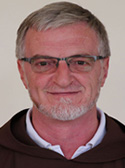
Fr. Roberto Genuin |
|
Minister Provincial |

Fr. Robin Victor D'Souza |
|
Provincial Council |

Fr. Paul Melwyn D'Souza
Vicar Provincial |

Fr Santhosh Naveen DSouza
2nd Councilor |

Fr Charles J R Furtado
3rd Councilor |

Fr Anthony Raj
4th Councilor |










 |
